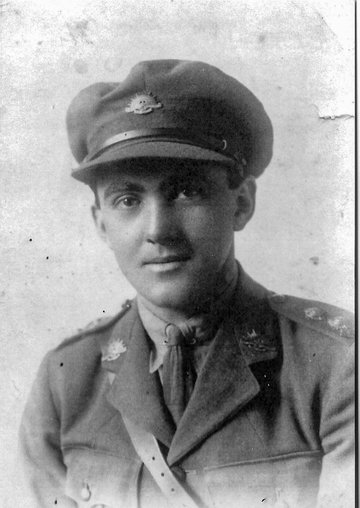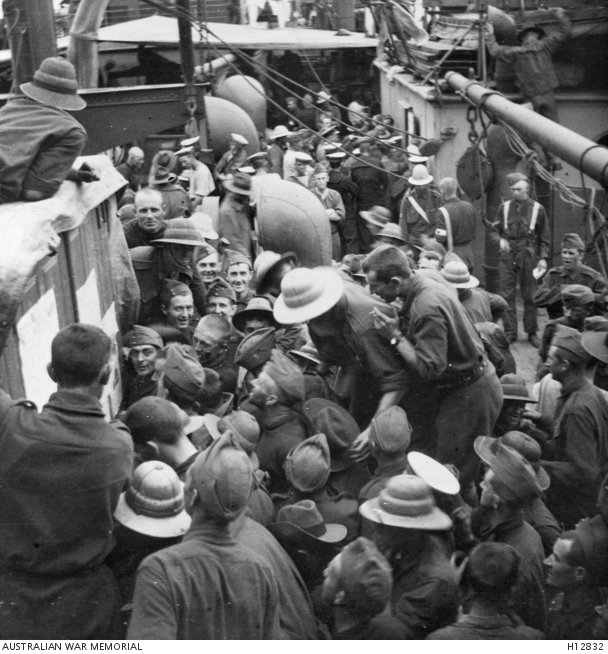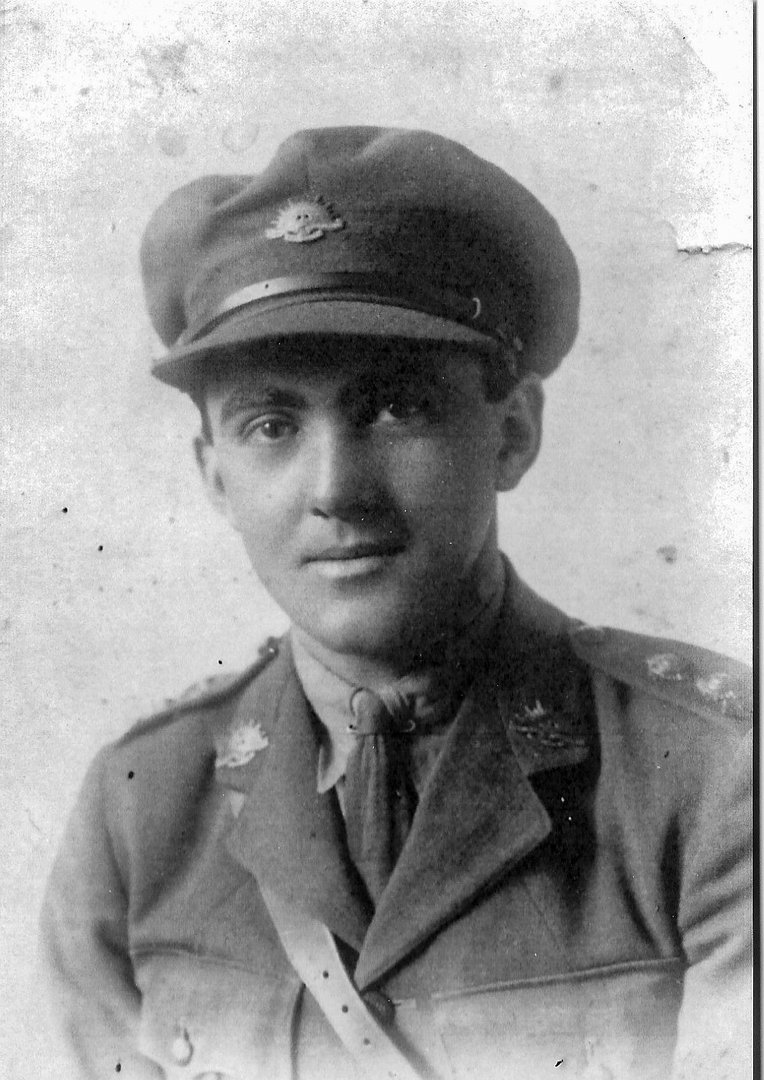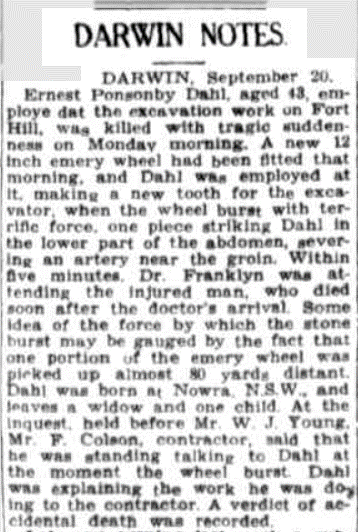Ernest Ponsoby DAHL
Eyes brown, Hair dark brown, Complexion dark
Ernie Dahl, of Norwegian stock
With many thanks to the Dahl family for the genealogy report, story, family memories and photos which have contributed to the creation of Ernie’s Fromelles story.
Ernie’s father came to Australia from Norway in the late 1880s. In recent years, the Australian branch of the Dahl family visited Norway and hired a professional genealogist to search the records for their family history.
His father was born on 1 January 1865 on the Dahl family farm at Vale, Vestfold, Norway to parents Hans Sorensen and Mary Thorsdottir. Christened Anton, his name was anglicized to Andrew when he came out to Australia; the backstory to the Dahl surname is not known and does not seem to follow usual Scandinavian naming customs.
Andrew arrived in Victoria, Australia on the cargo-carrying 3-masted sailing ship Broaderfolket on 24 January 1888, a carpenter seaman. It seems he jumped ship and was later listed as a deserter. The ship had sailed from Kristiona, Oslo on 26 August 1887.
On 19 June 1893, at the age of 28, Andrew married Ellen Jane Harris. Ellen was from a farming family near Berry, Illawarra in New South Wales. The wedding was conducted under the rites of the Church of England as were the christenings of the children born to the marriage. They had 4 children: a still born girl and then three boys - Ernest 1895, Andrew 1903, and Fred (Fridgoff) 1904.
By 1900, Andrew was a carpenter in Victoria Street in Goulburn where his wife was involved in advertising “Dr Williams’ pink pills” for headaches and all manner of ailments. And by 1912, Andrew was working as a foreman at the Railway Works Department at White Bay in Sydney. Sadly, Ellen died in September 1912 when the youngest son was just eight.
Ernie, aged about 17, was already working as an apprentice fitter, possibly living with his father in Sydney or maybe completing his apprenticeship in New Zealand. Fred and Andrew junior, the two younger boys, were sent via steamship to stay with Harris and Gray relatives in Byron Bay. Andrew junior returned to Sydney in his teens to become a steam fitter. Young Fred stayed on the North Coast for 30 years and became a butcher; he was also a skilled fitter. In 1914, Andrew senior remarried to Isabella Whelan but they divorced in 1919.
New Zealand connection
According to family and supported by his enlistment documents, Ernie went to New Zealand. The family are certain he completed a steam engine driver’s course there. Ernie’s AIF record says he was five years with Humphreys Brothers in Wellington NZ and that while there he joined military/militia training.
While ‘fudging’ his age on his enlistment papers by adding a couple of years, he maintained some consistency with the details given as to his employment and military experience. Ernie has two enlistment entries with the Australian forces in WW1, with two service numbers.
Part One of Ernie’s war service: AN&MEF 828 Private Ernie Dahl

Editor’s note:
We acknowledge our gratitude to Navy Media for permission to copy from their official page re the Berrima expedition and the AN&MEF.
The following extracts paraphrase their material with our additions relevant to Ernie.
Ernie was a part of the very earliest Australian engagement in WW1. Claiming to be 20 years 11 months and an engine driver, Ernie (actually still an 18-year-old) enlisted on 16 August 1914 and joined H Company, 1st Tropical Unit as a private (companies were A-H).
Three days later, Private Ernie Dahl boarded the ship Berrima which left Cockatoo Island, Sydney on 19 August 1914 carrying men of the Australian Naval and Military Expeditionary Force (AN&MEF), consisting of 500 Royal Australian Navy (RAN) Reserve personnel from South Australia, Victoria, New South Wales and Queensland and a hastily recruited battalion of 1000 infantry from New South Wales. Ernie was one of those new infantry recruits - still an 18-year-old. The AN&MEF was under the command of Colonel William Holmes, DSO, a veteran of the South African War. They were bound for Rabaul in German New Guinea to conduct Australia’s first overseas operation of the war. The operation to capture Rabaul, the seat of Government in German New Guinea, was also the RAN’s first joint and amphibious operation.
The Berrima arrived at Moreton Bay early on 21 August and rendezvoused off Sandy Cape on 22 August with the cruiser HMAS Sydney which then escorted her northwards.
The two ships reached the Great Palm Island near Townsville. There AN&MEF personnel were landed to carry out jungle training and rehearsals in preparation for the landing at Rabaul.
The capture of Rabaul
On the morning of 2 September 1914, Berrima sailed from the Great Palm Island under the escort of HMA ships Sydney, Encounter and the submarines AE1 and AE2. The convoy arrived at Port Moresby on the evening of 4 September, where it was met by the destroyers Parramatta, Warrego and Yarra and other support vessels, including the troop transport Kanowna with 500 Queensland soldiers embarked.
On 9 September, the convoy reached Rossel Island on the eastern tip of New Guinea and rendezvoused with Australia. It was there that Rear Admiral Patey, RN (commanding the Australian squadron) and Colonel Holmes discussed the impending operation for the occupation of Rabaul. Sydney and two destroyers were to be detached and 50 men from the naval contingent under Lieutenant Rowland Bowen, RAN, were subsequently transferred from Berrima to Warrego and Yarra to conduct a dawn landing on 11 September. 12 September would be Ernie’s 19th birthday.
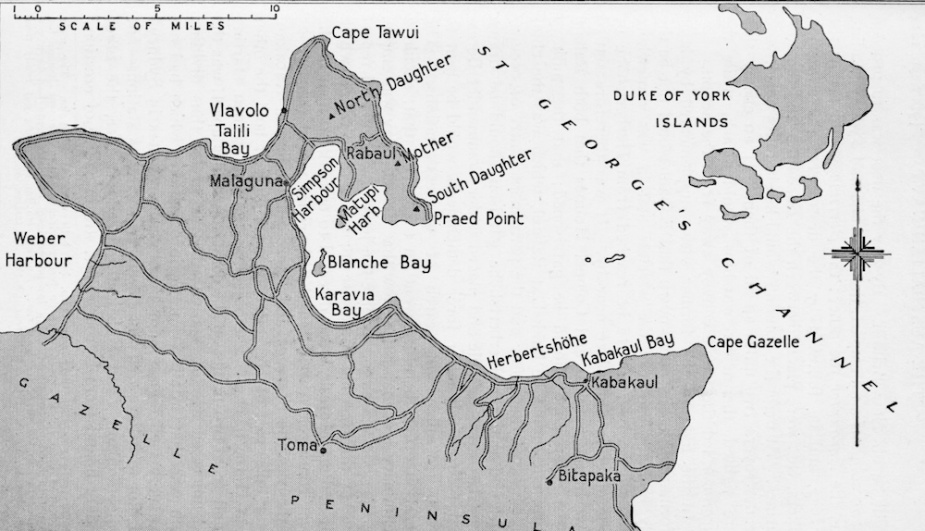
The initial landings commenced at Kabakaul and Herbertshöhe at 07:00 on 11 September 1914. German reserve soldiers and Melanesian troops initially offered resistance but then began to fall back.
Berrima later arrived under the escort of Australia. When the ‘all clear’ was given the two ships proceeded to anchor. In spite of training in Queensland, the infantry recruits were considered too inexperienced, so Ernie stayed on the ship and was a witness to the first shots fired in the war. They also saw the wounded brought on board as the hospital ship Grantala had not yet arrived at Rabaul and it was to Berrima that the wounded from ashore were brought.
Two companies of naval reservists, under Commander Joseph Beresford, RAN, and a military machine gun section were soon landed to support the advancing naval party ashore. Holmes kept the bulk of his military forces in Berrima until the situation ashore became clearer.
The German wireless station at Bitapaka was captured that evening and nearly 100 German troops (both army reservists and Melanesian auxiliaries) had been killed or captured. At 18:00 on 12 September Berrima went alongside the Nord Deutcher Lloyd wharf at Rabaul and began to disembark the remaining naval reservists and soldiers. Ernie and comrades stepped on to New Guinea soil.
Berrima’s guns and searchlights were manned as the location of the German East Asian Squadron was still unknown. On 17 September 1914 the German Governor surrendered the colony of German New Guinea to Colonel Holmes.
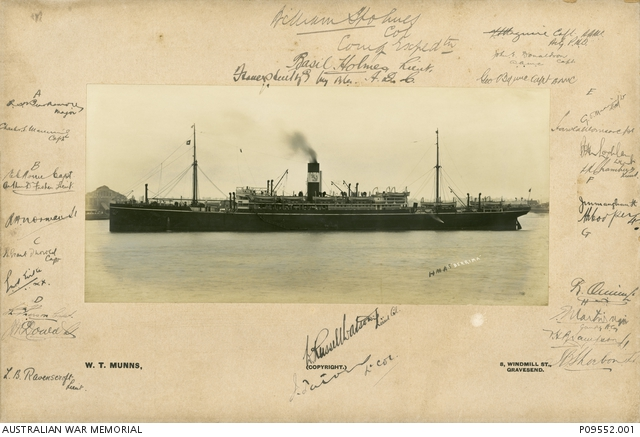
On 22 September 1914, Berrima departed Rabaul bound for Madang to disembark garrison troops and a company of naval reservists. As the location of the German East Asian Squadron was still unknown, she was escorted by Australia, Encounter and the French cruiser Montcalm. The convoy reached Madang on 24 September, and after the troops were disembarked the three ships returned to Rabaul on 26 September.
Berrima sailed from Rabaul on 4 October, carrying sick and wounded personnel bound for Sydney. She was accompanied by HMA Ships Yarra and Protector and HMS Fantome , with the latter two ships detaching at Townsville on 10 October. Berrima subsequently arrived in Sydney on 13 October 1914.
So that was Ernie’s unusual experience of that time, a very early skirmish in the world war that was to follow. The military enlistees were all discharged once they returned home with Ernie’s discharge dated 18 January 1915.
Part Two of Ernie’s war service: AIF 2978 Private Ernie Dahl
Ernie’s age and promotions
Having been discharged with all the other AN&MEF recruits from the Berrima , Ernie once more added to his age to enlist in May 1915. To clarify, Sydney baptism records indicate Ernie was born 12 September 1895 while his army file shows:
- In August 1914 he said he was 20 years 11 months (i.e. born July 1893) putting his age up by 2 years.
- In May 1915 he reported 23 years and 8 months (i.e. born September 1891) adding 4 years to his age.
- He also adjusted his background information, such as his previous military experience and employment history. It is only on his AIF enlistment records that he mentioned his New Zealand work and military history.
Ernie earned a number of promotions during his military career and, before his 23rd birthday, he was a lieutenant:
- August 1914 to Jan 1915 - enlisted as a private in the AN&MEF
- May 1915 – enlisted as a private in the AIF leaving Australia in September 1915 with the 3rd Battalion but transferred to the 53rd Battalion in February 1916 (Egypt)
- 16 March 1916 – promoted temporary corporal (Egypt)
- 8 May 1916 – promoted to sergeant and left for France and the Western Front in June 1916 where he was wounded and sent back to England
- 10 May 1917 – promoted to acting company sergeant major with 14th Training Battalion (England)
- 25 September 1917 – Temporary company quartermaster sergeant with 53rd Battalion (France)
- 19 November 1917 – promoted to second lieutenant with 53rd Battalion (France)
- 7 April 1918 – promoted to lieutenant with 53rd Battalion (France)
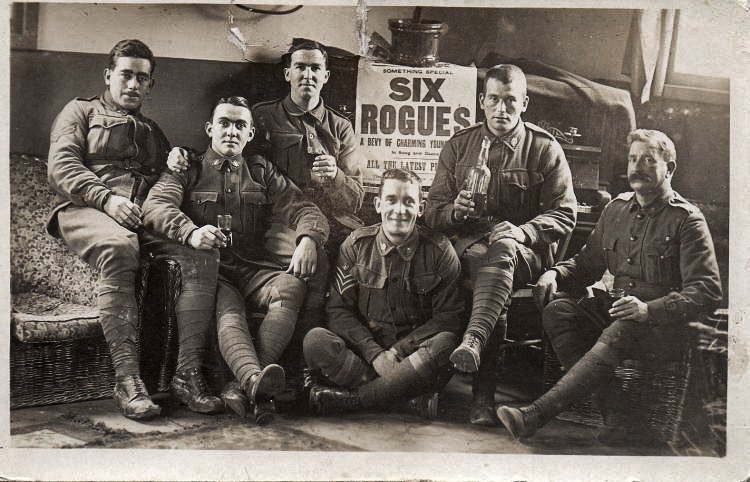
Ernie Dahl at Fromelles, France
In mid-June 1916, the 53rd Battalion was bound for France to join the British Expeditionary Force on the Western Front. Ernie, then a sergeant, left Egypt with the 32 officers and 952 soldiers on the Royal George arriving in Marseille on 28 June 1916. They then had a 62-hour train ride to Thiennes. It was noted that their “reputation had evidently preceded them”, as they were well received by the French at the towns all along the route.
After several days of marching the 35 kilometres to Fleurbaix, they were settled into billets on 16 July and by 0300 on the 17th were into the front lines.
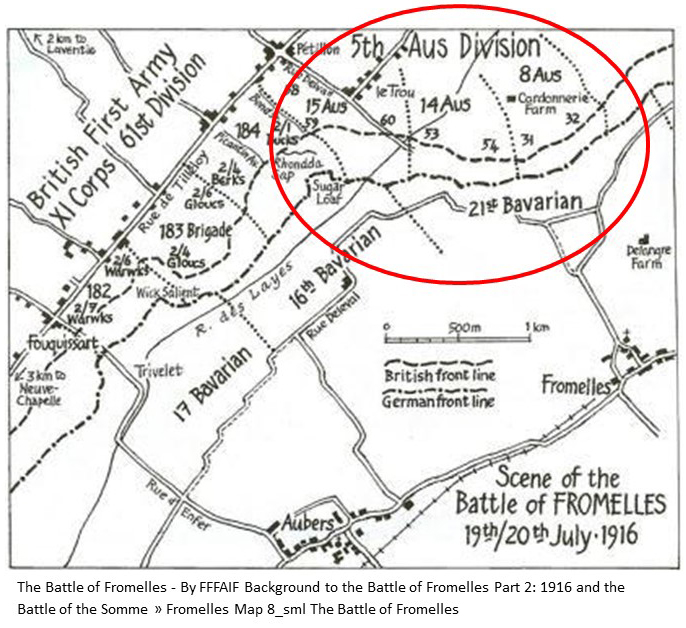
On the 18th, the 53rd Battalion took over the trenches held by the 54th, with the River Layes and the 60th Battalion on the left. There was severe bombardment all night, by both the British Expeditionary Force and by the Germans. At 4:00pm on July 19th, the 54th Battalion re-joined on the left.
The Australian attack began at 5:43pm. They initially took the German first and second line trenches, linking up with the 54th on the left, but no one could be found on their right. Their attacks continued and their lines were held through the night, but the Germans were counterattacking on their front and right flank and the trenches that were captured changed hands again. It took until midday on the 20th for the artillery bombardment to quieten down.
By 9:00am on July 20th, the 53rd received orders to retreat from positions won and by 9:30 they had “retired with very heavy loss”. By 4:30pm, the remains of the Brigade assembled at HQ. Of the 984 men who had left Alexandria just weeks ago, 372 were killed or missing and 335 were wounded, including Sgt Ernie Dahl suffering gunshot wounds.
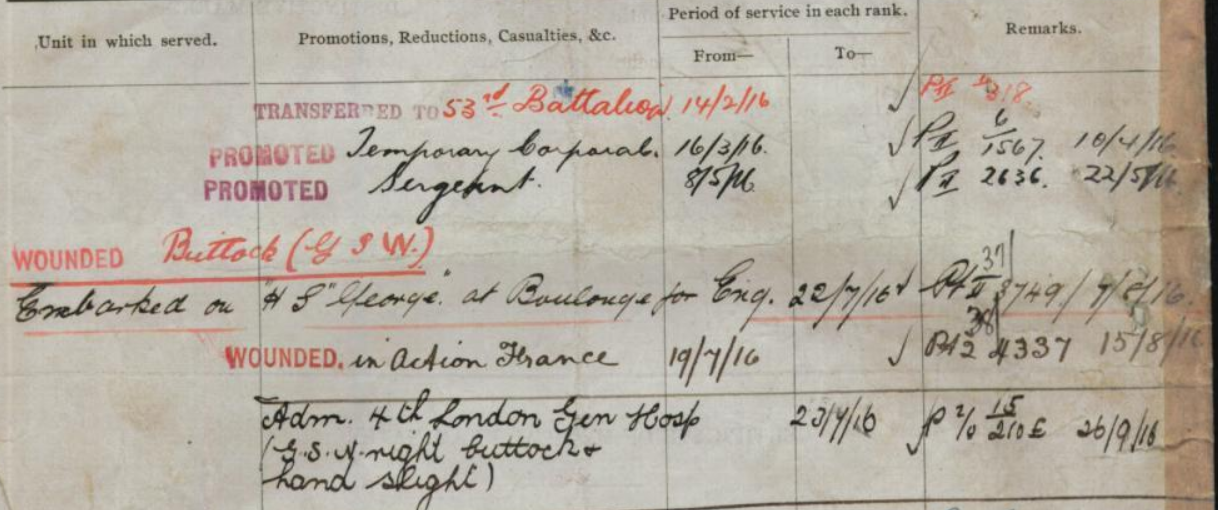
England
Ernie was evacuated to England for medical treatment initially at the 4th London General Hospital but from 3 August 1916 at a convalescent hospital at The Grange, Morden (south London). He was discharged from hospital on 11 September and given two weeks leave.
On completing his leave, he reported back to Perham Down and in October he was transferred to the 14th Training Battalion at Codford, south of Salisbury Plains in Wiltshire, then a depot for men evacuated from the front line but not yet fit to return to the front. Ernie was to spend a year in England in camps at Hurdcotte and Tidworth and was promoted in May 1917 to company sergeant major.
In September 1917, Ernie reverted to the rank of sergeant and returned to France. He was transferred back to the 53rd Battalion and promoted to temporary company quarter master sergeant on 25 September. This was just in time for the battle of Polygon Wood, a major battle beginning on 26 September. After this battle, the 53rd continued their rotations in and out of the trenches in both France and in the Flanders area of Belgium. In November, Ernie was promoted in the field to second lieutenant and, in December 1917, attended gas school training.
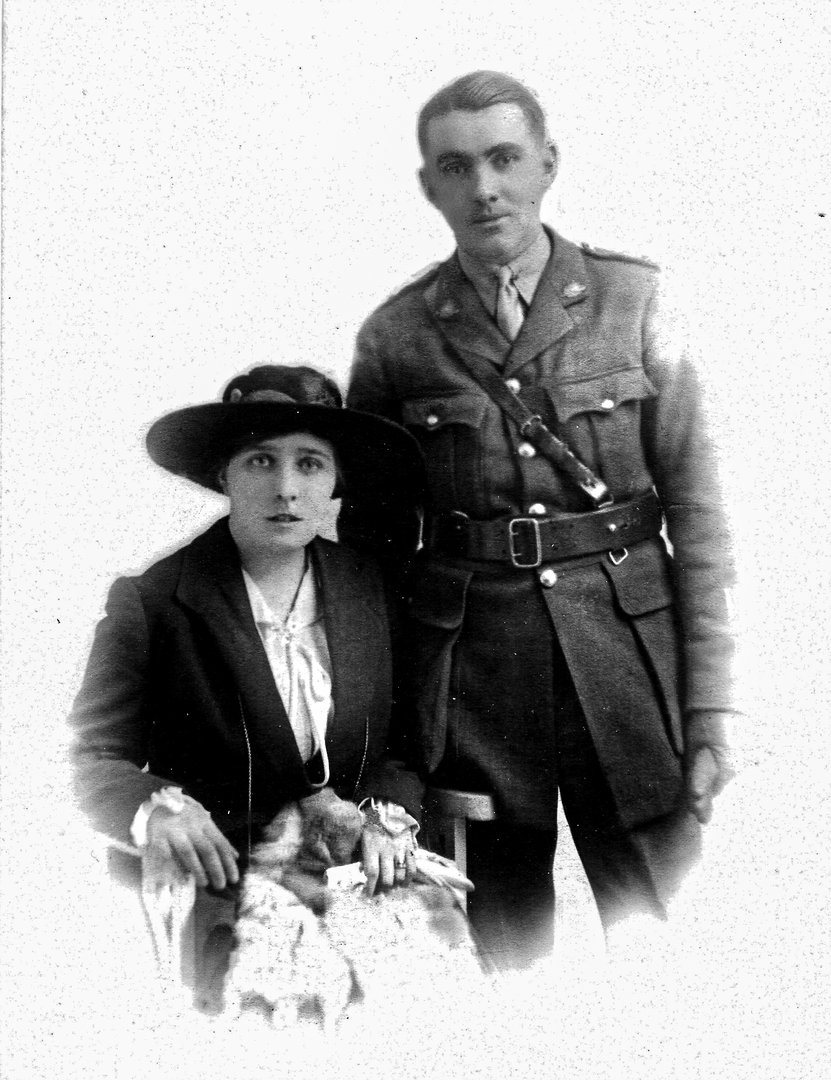
On 8 February 1918, he was granted leave “back in Blighty” and he took the opportunity to get married! Ernie married Margaret Anne Smith on 19 February in Holy Trinity Church in Weymouth, Dorset. It is presumed their courtship began during the twelve months Ernie spent in England while recovering from his wounding during the Battle of Fromelles. A week after the wedding – on 26 February - Ernie had to leave his new bride and returned to the Western front.
About a month after his return to France, Ernie fell ill with “pyrexia of unknown origin” (PUO), that is, persistent unexplained high temperatures. He was hospitalised on occasions during March and April but the fevers persisted and in late April / early May he was invalided and discharged to the base depot. Despite his ongoing illness, he was formally promoted to lieutenant effective from 7 April 1918.
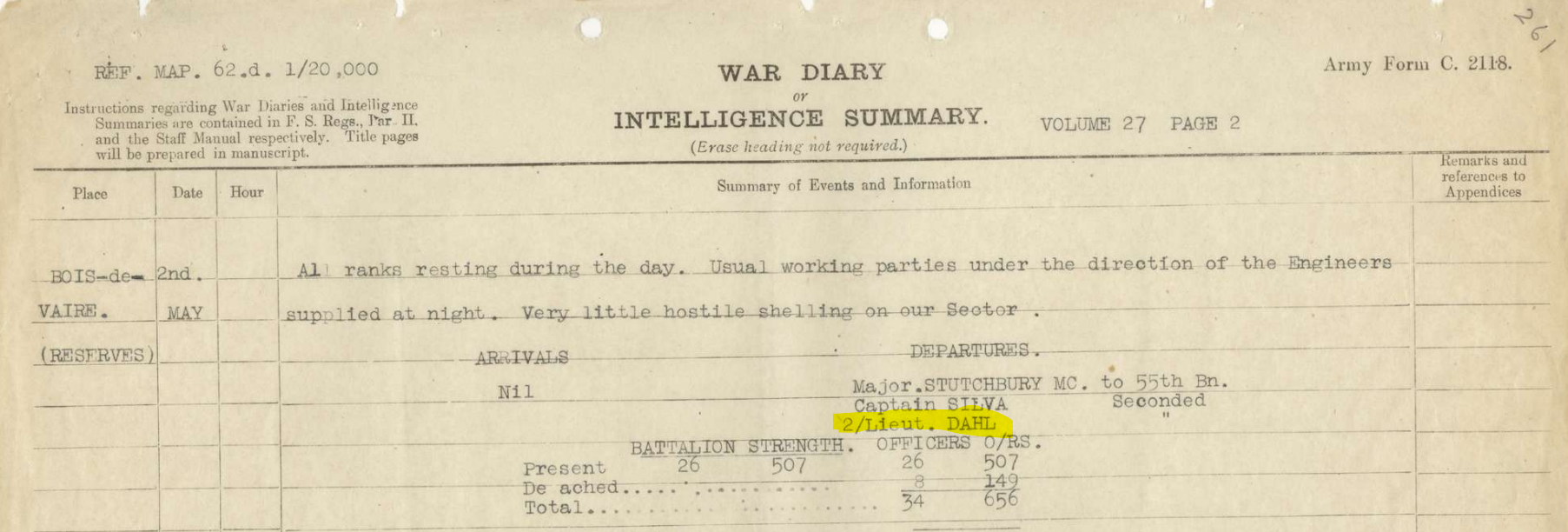
Ernie eventually went before a Medical Board on 24 May 1918 and they recommended that he be classified as B3 (suitable for sedentary work only) for one month and granted three weeks leave in England. On return to base depot in France, his B3 classification was extended for three months. Ernie continued on restricted duties until he was transferred back to the AIF base depot in England where he served until his return to Australia on Morvada in January 1919.
The Dahl Family
Maggie followed Ernie back to Australia arriving in July 1919 on board the ship Osterley . They went on to have a family of two sons and two daughters.
Meanwhile, Ernie returned to his engineer/mechanic profession including running a garage in Ungarie from 1925 to 1927. He also worked for other firms including the railways.

Ernie and Maggie divorced in about 1931 and he went on to marry May Jewkes in 1932 in South Australia. Ernie and May had one son.
Ernie died of an accident at his workplace in 1939 and is buried in the Darwin Cemetery. Any memorial on his site has gone, so it is now unmarked.
The Dahl family take great pride in Ernie’s war service and honour his memory. Some family members have been privileged to visit the battlefields where Ernie served.
The Fromelles Association would love to hear from you

Contacts
(Contact: royce@fromelles.info or geoffrey@fromelles.info).
(Contact: army.uwc@defence.gov.au or phone 1800 019 090).
Donations
If you are able, please contribute to the upkeep of this resource.
(Contact: bill@fromelles.info ).
